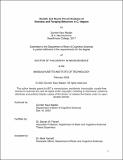Genetic and Neural Circuit Analyses of Sickness and Foraging Behaviors in C. elegans
Author(s)
Madan, Gurrein Kaur
DownloadThesis PDF (16.86Mb)
Advisor
Flavell, Steven W.
Terms of use
Metadata
Show full item recordAbstract
A fundamental goal of neurobiology is to decipher how the brain generates behaviors. Neuromodulation of brain circuits is thought to be critical for animals to generate long-lasting behavioral states crucial for survival. However, our understanding of the specific mechanisms by which neuromodulators alter circuit function to drive context-relevant and stable behavioral states remains limited. In this thesis, we provide new insights into the neuromodulation and neural circuit control of long-lasting behavioral states by focusing on sickness and foraging behaviors in the nematode Caenorhabditis elegans. The defined cell lineage and fully mapped connectome of C. elegans, combined with cutting-edge genetic and imaging tools, allow us unprecedented access into the study of these behaviors. In Chapter 1, we review the literature on the neural mechanisms of sickness and foraging behaviors, covering research across model organisms, with an emphasis on findings in C. elegans. In Chapter 2, we show that neuromodulatory pathways linked to stress and satiety are recruited upon pathogen infection to drive sickness behaviors. These pathways include FMRFamide peptides and the TGF-beta/DAF-7 neuromodulator, which are released from distinct neural sources and in distinct combinations to drive state-dependent behaviors. In Chapter 3, we reveal the functional architecture of a neural circuit that enables flexible, sensory-driven control of persistent behavioral states that underlie C. elegans foraging. In this work, we identify the sensory-processing AIA neuron as the basis of context-appropriate behavioral state transitions. Then in Chapter 4, we lay a foundation for further investigation of the regulation of foraging behaviors. To do so, we perform genetic and imaging studies on the NSM and I6 neurons that are part of the nervous system in the foregut (pharynx). Collectively, these three thesis projects expand our mechanistic understanding of the neuromodulatory and circuit control of long-lasting behavioral states.
Date issued
2024-02Department
Massachusetts Institute of Technology. Department of Brain and Cognitive SciencesPublisher
Massachusetts Institute of Technology